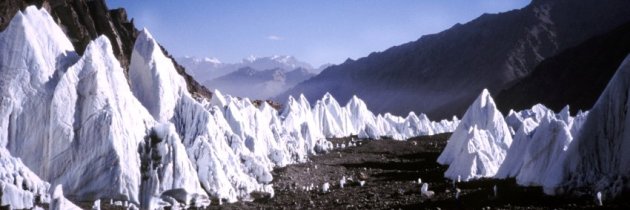Chinese Glacier’s Retreat Signals Trouble for Asian Water Supply
Over the years, Qin Xiang and his fellow scientists at a high and lonely research station in the Qilian Mountains of northwest China have tracked the inexorable effects of rising temperatures on one of China’s most important water sources. “The thing most sensitive to climate change is a glacier,” said Dr. Qin, 42, as he slowly trod across an icy field of the Mengke Glacier, one of the country’s largest. “In the 1970s, people thought glaciers were permanent. They didn’t think that glaciers would recede. They thought this glacier would endure. But then the climate began changing, and temperatures climbed.”
Beneath Dr. Qin’s feet, the cracking ice signaled the second-by-second shifting of the glacier.
The extreme effects predicted of global climate change are already happening in western China. Glacier retreat here and across the so-called Third Pole, the glaciers of the Himalayas and related mountain ranges, threatens Asia’s water supply. Towns and villages along the arid Hexi Corridor, a passage on the historic Silk Road where camels still roam, have suffered floods and landslides caused by sudden summer rainstorms. Permafrost is disappearing from the Tibet-Qinghai Plateau, jeopardizing the existence of plants and animals, the livelihoods of its people and even the integrity of infrastructure like China’s high-altitude railway to Lhasa, Tibet.
The fact that Chinese scientists are raising alarms about these changes is a key reason that the Chinese government has been engaging fully in climate change negotiations in recent years. Another is the deadly urban air pollution, caused mostly by industrial coal burning, that resulted in Beijing’s first red alert over air quality on Monday.
China, which remains the world’s largest emitter of greenhouse gas, pledged last year to begin lowering carbon dioxide emissions around 2030, and in Paris this month, President Xi Jinping reiterated his resolve to help slow climate change. There are no vocal climate change deniers among top Chinese officials.
In November, China released a detailed scientific report on climate change that predicted disastrous consequences for its 1.4 billion people. Those included rising sea levels along the urbanized coast, floods from storms across China and the erosion of glaciers. More than 80 percent of the permafrost on the Tibet-Qinghai Plateau could disappear by the next century, the report said. Temperatures in China are expected to rise by 1.3 to 5 degrees Celsius, or 2.3 to 9 degrees Fahrenheit, by the end of the century, and temperatures have risen faster in China in the last half-century than the global average.
People across China are already feeling the impact. The most obvious devastation comes from flooding. The report said an increase in urban floods attributed to climate change has destroyed homes and infrastructure. From 2008 to 2010, 62 percent of Chinese cities had floods; 173 had three or more.
“China is more prone to the adverse effects of climate change because China is vast, has diverse types of ecology and has relatively fragile natural conditions,” Du Xiangwan, chairman of the National Expert Committee on Climate Change, wrote in the report’s introduction.
Last weekend, Chinese scientists released a separate report that said the surface area of glaciers on Mount Everest, which straddles the Tibet-Nepal border, have shrunk nearly 30 percent in the last 40 years. Vanishing glaciers raise urgent concerns beyond Tibet and China.
By one estimate, the 46,000 glaciers of the Third Pole region help sustain 1.5 billion people in 10 countries — its waters flowing to places as distant as the tropical Mekong Delta of Vietnam, the hills of eastern Myanmar and the southern plains of Bangladesh. Scattered across nearly two million square miles, these glaciers are receding at an ever-quickening pace, producing a rise in levels of rivers and lakes in the short term and threatening Asia’s water supply in the long run.
A paper published this year by The Journal of Glaciology said the retreat of Asian glaciers was emblematic of a “historically unprecedented global glacier decline.”
“I would say that climatologically, we are in unfamiliar territory, and the world’s ice cover is responding dramatically,” said Lonnie G. Thompson, a glaciologist at Ohio State University who helped found a project to study climate change on the Tibetan Plateau.
Across China, the surface area of glaciers has decreased more than 10 percent since the 1960s, according to the climate change report. The report linked the expected water scarcity to national security, noting that “in the future, disputes between China and neighboring countries on regional environmental resources will keep growing.”
Read more on The New York Times



